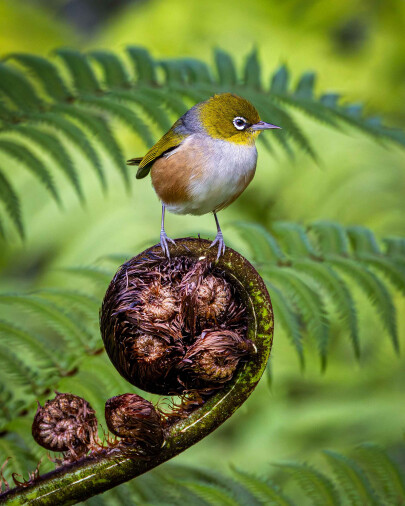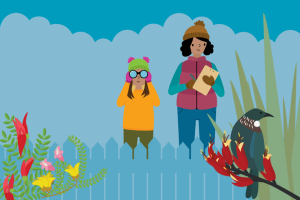Thousands of New Zealanders have their pencils sharpened and at the ready for the start of the 19th New Zealand Garden Bird Survey | Te Tatauranga o ngā Manu Māra o Aotearoa on Saturday 28 June.

Silvereye. Image: Graham Murphy
As New Zealand/Aotearoa’s longest-running citizen science project, the NZ Garden Bird Survey performs an invaluable role in tracking how our birds are faring, especially in urban and rural environments.
Once submitted and analysed, the huge amounts of data provided by citizen scientists nationwide – more than 77,000 surveys since 2007 – shape the story of how bird counts are changing across the country over two timeframes – the past 5 and past 10 years.
According to Manaaki Whenua – Landcare Research Senior Researcher Dr Angela Brandt, the ongoing data collection is showing how the trends for each species might be changing over time. The results from the State of NZ Garden Birds | Te āhua o ngā manu o te kāri i Aotearoa 2024 had good and bad news for four of our native species. While tūī (kōkō) and fantail (pīwakawaka) continue to show increasing trends, and the national declines in silvereye (tauhou) counts have lessened, we are seeing short-term declines for kererū at the national scale and in seven regions.
“In the latest report, we see a tapering off of national declines for silvereye and increasing trends in their counts in 10 regions, which is heartening. But short-term declines are emerging for several species, including kererū and three introduced songbirds,” Dr Brandt says.
Because these bird trends often vary by region, it’s beneficial to have more people taking part in the survey to enable us to detect when a regional trend is different to the national trend. “We received a record number of surveys in 2024, and I’d love to see if each region can come out in force for their garden birds again,” Dr Brandt says.
Now is the perfect time to create a birding memory, especially if you’ve never done the Survey before. The NZ Garden Bird Survey website has a whole host of bird identification pages, bird song examples, and tips on how to get the best out of your Survey experience.
Doing the survey is great for people, too. Back in 2020, we asked participants about their experience taking part. Some people responded that they liked participating in a large collective effort like the NZ Garden Bird Survey because they didn’t have time to join a conservation or nature group. Most people also reported a greater sense of wellbeing after spending time counting birds in the garden. “We had people saying it was a good opportunity to slow down,” says Manaaki Whenua Senior Researcher Dr Gradon Diprose. “Participants talked about feeling curiosity, joy, fun, wonder and a sense of connection.”
Teachers and families can enrich the learning experience around the NZ Garden Bird Survey with a bilingual lesson plan, developed in partnership with the Science Learning Hub, which explores learning about birds through a te ao Māori lens. Kairangahau Māori Yvonne Taura says the aim was to engage kura Māori in manu education and show they have a role to play in protecting their local environment. “We’ve built a curriculum that will be a scaffold for learning opportunities in kura. By showing manu in the environment and how they are impacted by urban development, we can encourage kaitiakitanga and an understanding of our manu taonga.”
It’s easy to take part :
- Visit the NZ Garden Bird Survey website to get started.
- Select a garden or a local park
- Choose any ONE day between 28 June and 6 July.
- Look and listen for birds on that day for ONE hour.
- For each species, record the HIGHEST number seen or heard at one time.
- Submit the results online via the NZ Garden Bird Survey website’s Take Part page.


